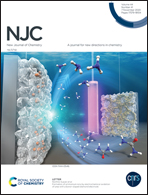A facile size tunable one-pot synthesis of dipicolinate@nZVI core–shell nanoparticles: material properties for trace cadmium ion removal
Abstract
In this work, a low-cost method of functionalization of zero-valent iron nanoparticles (nZVI) by dipicolinic acid (2,6-pyridinedicarboxylic acid, PDCA) through one-pot chemical synthesis was applied. The synthesized PDCA@nZVI nanomaterial was characterized via scanning electron microscopy, energy dispersive spectroscopy, X-ray diffraction, and Fourier-transform infrared spectroscopy. Functionalization by PDCA produced core–shell nanoparticles with magnetite and feroxyhyte mixed oxide layers. Tuning of particle size and shape was achieved by using different molar ratios of starting reagents during synthesis. The formation of short-chains of larger spherical particles was observed after the use of an equimolar (1 : 1) ratio of PDCA to iron ions and aggregated smaller ellipsoidal particles were produced after the use of a 1 : 2 molar ratio. The applicability of differently shaped nanomaterials for trace Cd ion removal from aqueous solutions was tested using the ICP-OES method. The removal efficiency achieved when using 10 mg of the functionalized PDCA@nZVI nanomaterial was 100% at cadmium levels below 5 mg L−1. The removal capacities were 77.6 mg g−1 for bare nZVI particles, 80.3 mg g−1 for one-pot synthesized PDCA@nZVI 1/1, and 110.2 mg g−1 for the one-pot synthesized PDCA@nZVI 1/2 material. Specific sorption properties of the PDCA@nZVI material in the presence of trace levels of Cd were observed through the measurement of hydrodynamic diameter and change of zeta-potential in solutions. The differences in sorption between spherical and ellipsoidal particles at low Cd concentrations are explained through the effects of intraparticle and surface diffusion steps. Comparison of removal efficiency after Cd sorption on bare nZVI particles, one-pot synthesized PDCA@nZVI particles, and the particles obtained by subsequent incubation revealed that adsorption was enhanced when using the one-pot synthesized nanomaterial.



 Please wait while we load your content...
Please wait while we load your content...